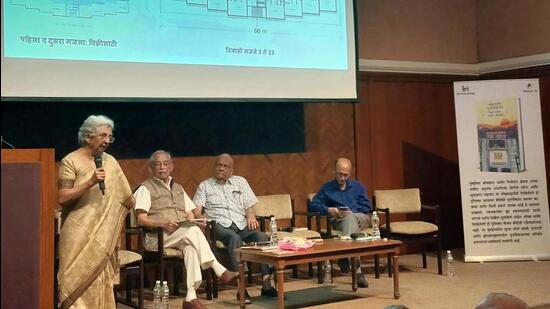Urban planners lambast ‘profiteering’ MHADA plan for BDD Chawls redevelopment
Some of the city’s best-known urban planning experts came together on Saturday and critiqued the MHADA plan for the redevelopment of BDD Chawls at Worli, Naigaum and N M Joshi Marg, saying it was aimed at profiteering from the free sale component
Some of the city’s best-known urban planning experts came together on Saturday and critiqued the MHADA plan for the redevelopment of BDD Chawls at Worli, Naigaum and N M Joshi Marg, saying it was aimed at profiteering from the free sale component. The experts suggested an alternative and viable model of redevelopment focused on providing better homes, open spaces and amenities to the BDD Chawls residents.

Well-known urban planner Shirish Patel and architect Sulakshana Mahajan made a presentation of their alternative plan at a meeting held at Nehru Centre on Saturday. The plan has been published as a 44-page booklet by Lokvanmay Gruha titled ‘BDD Chawls at Worli: How they should not be, how they should be’. Former municipal commissioner D M Sukhtankar and urban planner V K Phatak also joined them in a discussion.
Patel and Mahajan criticised the existing plan designed by MHADA, and approved by the government, on several counts. Citing the National Building Code (NBC), they said that the latter prescribed the density of low-income group housing at 400 to 500 units per hectare. However, the MHADA plan had increased this to 600 and 800 per hectare. The NBC also prescribes a maximum FSI of 4, but the MHADA plan “unnecessarily increases this”—FSI for residential homes in the plan is between 4 and 8, and with parking, staircases, and lifts, could go as high as 9 to 11.
The experts also denounced the proposal to have rehab buildings of 23 floors in N M Joshi Marg and Naigaum and free sale buildings of 45 floors. For Worli, the proposed rehab buildings are 40 floors high with two floors of parking podiums, and the proposed free sale buildings have 66 floors with 10 floors of parking. The plan also proposes a huge number of podium parking spots, including 3,170 at N M Joshi Marg, 4,747 at Naigaum, and 10,000 at Worli.
Additionally, the MHADA plan restricts open spaces, reserves very little distance between two tall buildings and reduces the ratio of open space per person from 2 sq m to 0.51 sq m and 0.65 sq m in the N M Joshi Marg and Naigaum plans. The urban planners said the proposed plan would reduce natural light and air circulation in rehab homes and impact the health and well-being of their occupants.
Patel and Mahajan unveiled their alternative plan, which has more open spaces, encourages the preservation of existing sports grounds, and proposes a total development area of 10,22,000 sq m compared to MHADA’s 23,67,000 sq m. It also eliminates the free sale buildings and transit accommodation completely. The alternative plan proposes eight flats per floor and residential units from three to 23 floors.
The alternative plan proposes commercial establishments like hospitals, schools and retail spaces on the ground, first and second floors. “The market rate for commercial spaces in Worli is significantly higher than the residential rate, and selling these spaces can easily cover the cost of the rehab buildings and even generate a small surplus,” Mahajan said.
Sukhtankar revealed that when he headed the civic body, buildings in Lallubhai Compound and Natwar Compound were built with poor ventilation and natural light. Later, a survey by ‘Doctors For You’ had shown that the prevalence of tuberculosis was higher in these buildings.
“This is a documented example of how constricted living spaces impact the health and well-being of residents. What the government has approved is a violation of the Right to Life, a fundamental right. This is just criminal and the government pushing this plan is shameful,” Sukhtankar said.
Phatak had an interesting point to make—that the DCPR 2034, the development plan for the city, had incorporated DC Regulation 33 (9) which mentions 500 sq ft homes for BDD Chawl residents, and 70 to 100 per cent incentive FSI. “Presently, the residents live in 160 sq ft homes with 1 FSI. For 500 sq ft homes, you will need at least 3 FSI,” he said. “With 70 per cent incentive FSI, the FSI will rise to 5, and with 35 per cent additional fungible FSI, it may touch 7 FSI. So tomorrow MHADA can’t be faulted for profiteering, as the DC rules already have this provision and MHADA can simply say it is following the laid-down rules.”
Patel, who has filed a writ petition in the Bombay high court objecting to the MHADA plan, said there was no requirement for transit camps in the alternative plan as in-situ rehabilitation was possible. “One building can be constructed, and 320 residents of four buildings could be first rehabilitated in them,” he said. “Two new buildings could be constructed in place of those four buildings and 640 residents from eight buildings could be moved into them and so on and so forth. Rehabilitation can be completed in five phases.”



